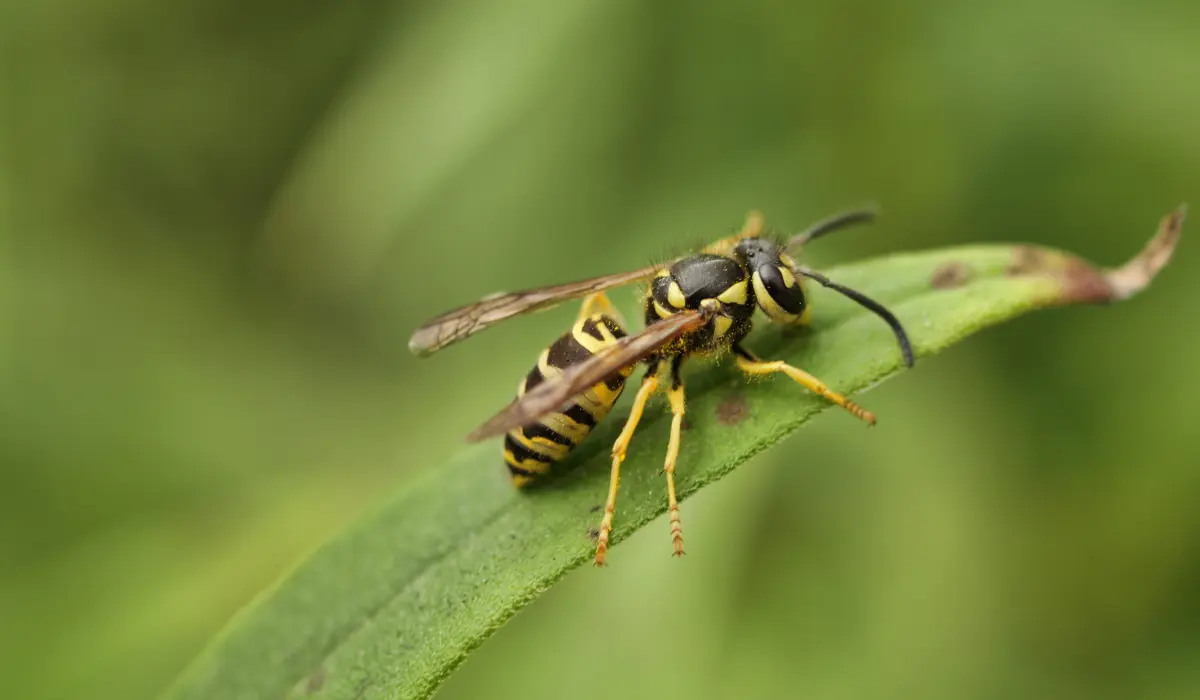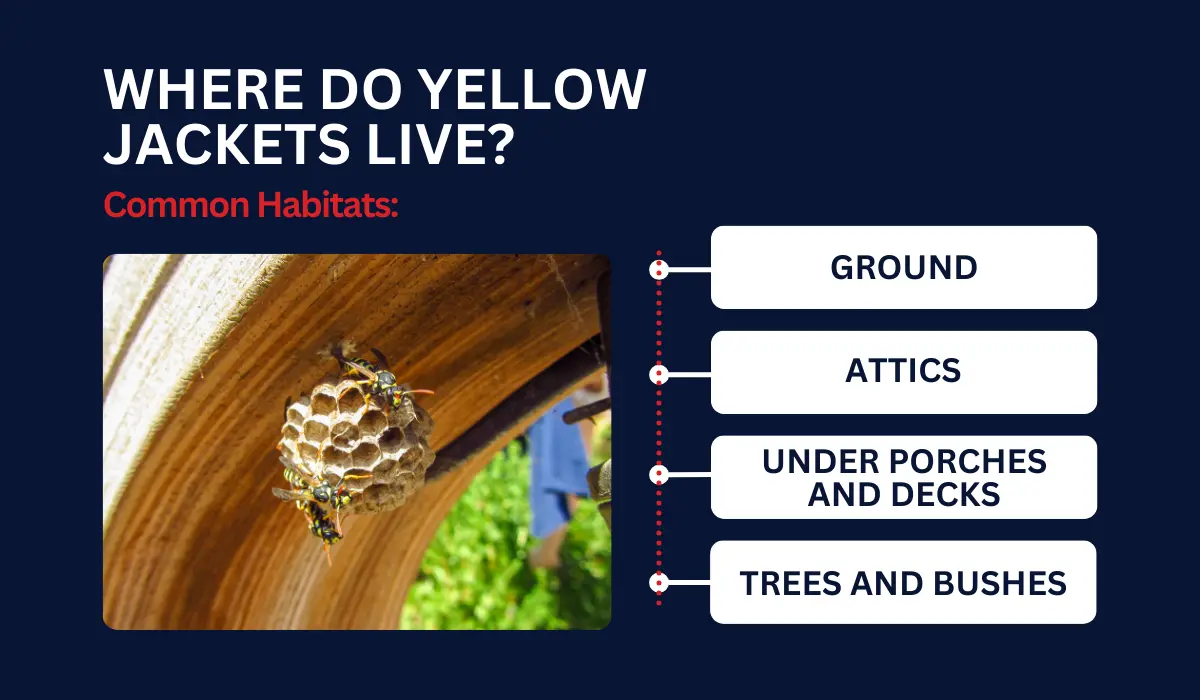
Yellow jackets in Louisiana are more than just a summer nuisance; these aggressive wasps can impact outdoor activities and safety.
They build their nests in various locations, including underground, in wall cavities, or hanging from structures, making them hard to avoid.
Do you know how to protect yourself and your family from yellow jackets? Keep reading to make your outdoor experiences in Louisiana safer and more enjoyable.
Key Takeaways
- Unlike bees, yellow jackets in Louisiana are identifiable by black and yellow bands and a narrow waist that can sting multiple times.
- They build nests in diverse environments, such as underground burrows, attics, and tree branches, thriving in urban and rural areas.
- Their stings can cause severe pain, allergic reactions, and even anaphylactic shock, posing a risk to humans, pets, and livestock.
- To prevent infestations, remove food sources, secure trash, and consider plant repellents. In severe cases, professional help may be needed.
WHAT ARE YELLOW JACKETS?
Yellow jackets from the genera Vespula and Dolichovespula are a common type of wasp in Louisiana.
Recognizable by their distinct markings, they are both fascinating and sometimes a nuisance due to their aggressive behavior.
Physical Appearance
Yellow jackets stand out among wasps due to their vibrant colors and distinctive body structure. Their size varies, similar to other wasps, but often smaller than paper wasps or bald-faced hornets.
These characteristics differentiate them from bees and other wasp species:
| Physical Characteristics | Details |
|---|---|
| Colors | Alternating black and yellow bands |
| Size | 3/8th and 5/8th of an inch (12-16 mm) |
| Body Structure | Narrow waist connecting the thorax and abdomen |
| Wings | Transparent and folded back when at rest |
Behavior and Character
Yellow jackets are known for their social structure and aggressive behavior. Like other types of wasps, they live in colonies with a queen, workers, males, larvae, and eggs. They build nests out of chewed wood fibers, often underground or in sheltered areas.
Their aggressive nature makes them notorious, especially near food sources. Unlike bees, which lose their stinger after a single sting, they can sting multiple times.
WHERE DO YELLOW JACKETS LIVE?

Yellow jackets are commonly found in various environments across Louisiana. They build their nests in diverse locations, including human-occupied spaces and natural settings.
Common Habitats
Yellow jackets can thrive in both urban and rural areas. These wasps build their nests in places that provide shelter and are close to food sources.
Yellow jacket nests are often found in the following locations:
- Ground: Frequently, they build nests underground in old rodent burrows or densely wooded areas.
- Attics: They may also be found in attics, wall cavities, and around house structures.
- Under Porches and Decks: These shaded areas protect from the elements, making them attractive nesting sites.
- Trees and Bushes: Nests can be spotted hanging from tree branches or in dense shrubs.
Areas in Louisiana
Yellow jackets can be found anywhere in Louisiana, including major cities and rural spots. Each area has unique factors that could affect yellow jacket populations and behaviors.
- New Orleans: This urban setting provides numerous hiding spots in buildings and parks.
- Baton Rouge: Known for its green spaces, it offers ample opportunities for these insects to nest.
- Lake Charles: This region’s mix of urban and rural areas creates diverse nesting grounds, from backyards to fields.
WHY ARE YELLOW JACKETS A PROBLEM?
Yellow jackets can be a nightmare for anyone living in Louisiana. They can sting multiple times, causing severe pain and allergic reactions. Their stingers inject venom that can lead to swelling and, in some cases, anaphylactic shock.
They can also harm pets and livestock. Curious pets might stumble upon a nest and get stung, which is particularly harmful to animals with allergic reactions. Livestock getting stung can also lead to injuries or stress.
HOW TO SPOT YELLOW JACKET INFESTATIONS
Yellow jacket infestations can be troublesome. Here are some signs to watch for:
- Increased Activity: Seeing more wasps than usual around your home or garden, especially between late summer and early fall, could indicate an infestation.
- Nesting Sites: Spotting a paper-like comb structure or hearing rustling sounds from walls can signal their presence.
- Frequent Stings: If you or your pets get stung more often, it may be a sign that they have a nearby nest.
- Foraging Behavior: Their increased foraging behavior indicates that their nest is nearby.
- Telltale Holes in the Ground: Sometimes, they build nests underground. Spotting holes with frequent flying activity can point to an infestation.
HOW TO KEEP YELLOW JACKETS AWAY
Since these stinging insects can pose health risks, here are some easy-to-follow tips to keep them at bay:
| Preventive Measures | Description |
|---|---|
| Remove Attractants | Don’t leave food or drinks outside, especially sugary items. |
| Regular Inspections | Check your property for nests, especially in hidden spots. |
| Secure Trash | Keep trash bins sealed and dispose of food waste promptly. |
| Plant Repellents | Grow plants like spearmint or eucalyptus that deter wasps. |
| Minimize Water Sources | Fix leaky faucets or standing water that may draw insects. |
| Seal Entry Points | Repair screens and seal cracks to prevent yellow jackets from entering your home. |
IS IT TIME TO CALL THE PROFESSIONALS?
When there are too many yellow jackets for DIY pest control methods to be effective or multiple stings are causing severe reactions or anxiety about outdoor activities, you should consider calling pest control professionals.
Whether you’re in Baton Rouge or New Orleans, seeking expert help should be easy. For immediate intervention for a severe infestation, let Lajaunie’s wasp & hornet control specialists tailor a solution that’s right for your home.
For more information about the areas we service, visit our location page.